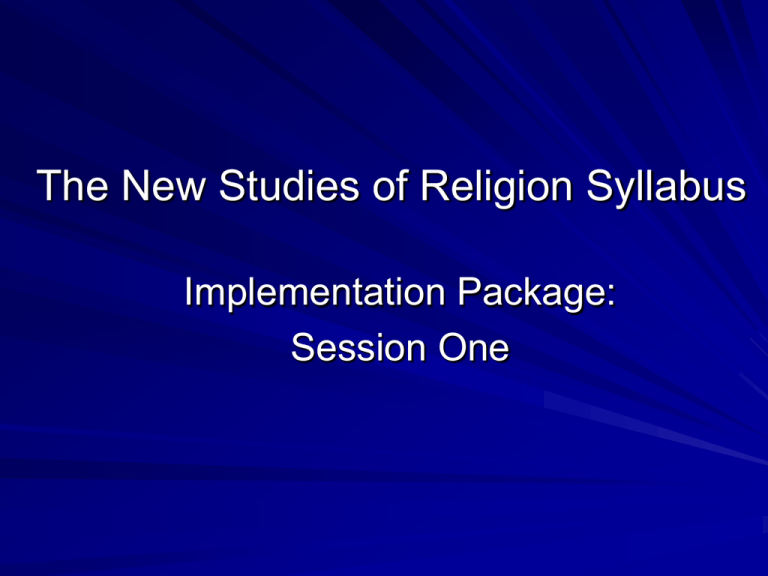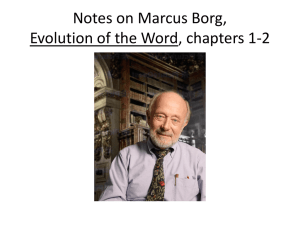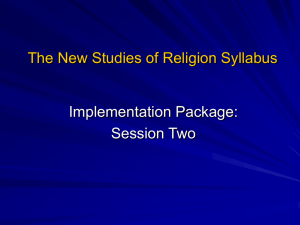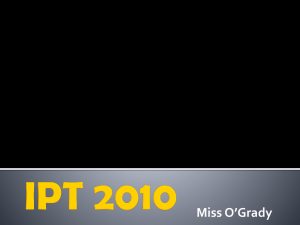New Studies of Religion Syllabus
advertisement

The New Studies of Religion Syllabus Implementation Package: Session One This session of the implementation package explores the following aspects of the New Syllabus: Overview of course structure Features of the new syllabus A process for comparing the old and new syllabi to assist teachers in programming for Preliminary Course implementation in 2006. The following tables: Provide an overview of the content of the Preliminary and HSC Course Show indicative hours for each component of the course Highlight additional 2 Unit topic areas Highlight significant features of the syllabus content pages Preliminary Course SOR I Duration SOR II Indicative Hours Duration Indicative Hours Nature of Religion and Beliefs 16 Nature of Religion and Beliefs 16 Religious Tradition Study 1 22 Religious Tradition Study 1 22 Religious Tradition Study 2 22 Religious Tradition Study 2 22 Religious Tradition Study 3 22 Religions of Ancient Origin 22 Religion in Australia pre-1945 16 Total 60 hours Total 120 hours HSC Course SOR I Duration SOR II (indicative hours) Duration (indicative hours) Religion and Belief Systems in Australia – Post 1945 16 Religion and Belief Systems in Australia – Post 1945 16 Religious Tradition Depth Study 1 22 Religious Tradition Depth Study 1 22 Religious Tradition Depth Study 2 22 Religious Tradition Depth Study 2 22 Religious Tradition Depth Study 3 22 Religion and Peace 22 Religion and Non-Religion 16 Total 60 hours Total 120 hours Significant Features of the New Syllabus Content Assessment Religious Traditions Chiasmic structure 2 Unit additional material Incorporating current material Buddhism 22 indicative hours The focus of this study is Buddhism, one of the major religious traditions, as a living religious system. An overview linking key Outcomes features and issues to the content of the study The outcomes A student: are linked to the P3investigates religious traditions and belief systems P4examines significant aspects of religious traditions content P5describes the influence of religious traditions in the life of adherents P6selects and uses relevant information about religion from a variety of sources P7undertakes effective research about religion, making appropriate use of time and resources P8uses appropriate terminology related to religion and belief systems P9 effectively communicates information, ideas and issues using appropriate written, oral and graphic forms. Content Students learn about: Students learn to: Origins the historical and cultural context in which Buddhism began the Buddha the formation of the Sangha the early councils, including the first council at Rajagaha and the second council at Vesali outline the historical and cultural context in which Buddhism began examine the principal events of the Buddha’s life, including the enlightenment explain why the Buddha is the model of Buddhist life describe the early formation of the Sangha within the first five years, including Mahapajapati’s request for a female Sangha identify the importance of the first two councils in the development of Buddhism Content expressed as Students learn about statements in conjunction with Students learn to statements CONTENT Outcomes focused: breadth and depth are clearly indicated Clarity of what students are required to do: LEARN ABOUT – content LEARN TO DO – application of skills via glossary terms ‘Learn about’ and ‘Learn to’ Students learn about: Students learn to: The Nature of Religion religion as a worldview that: - acknowledges the supernatural dimension - has a belief in a divine being or powers beyond the human and/or dwelling within the individual • define the supernatural dimension • characteristics of religion: • define the characteristics of religion - beliefs and believers sacred texts and writings ethics rituals and ceremonies the contribution of religion Australian Aboriginal Beliefs and Spiritualities – The Dreaming • nature of the Dreaming the inextricable connection of the Dreaming, the land and identity • discuss a transcendent religious worldview which has a belief in a divine power and/or powers beyond the human • discuss an immanent religious worldview which has a belief in a divine being or powers dwelling within the individual • explore the ways in which these characteristics interact to • create a dynamic, living religion • appreciate the contribution of religion to: - individuals - society and culture • outline the nature of the Dreaming in relation to: - origins of the universe - sacred sites - stories of the Dreaming - symbolism and art • discuss the diversity of the Dreaming for Aboriginal peoples • recognise the importance of the Dreaming for the life of Aboriginal peoples • investigate the inextricable connection of the Dreaming, the land and identity ASSESSMENT ~ Syllabus p53ff Succinct explanation of what is required and suggested (note the difference!) Encourages flexibility and creativity – student centred, assessment for and of learning. Provides scope for meaningful research. When developing a schedule of assessment tasks, there should be a balance across: - the assessment of knowledge and understanding and skills outcomes - types of assessment tasks such as research, written response, analysis of stimulus material, oral presentation, and test/examination tasks. Oral tasks might include: - a formal oral presentation before a selected audience - a viva voce Research might involve: - formulating an hypothesis or a set of questions on a topic locating and organising information from a variety of sources (these could include written, audiovisual, multimedia sources or questionnaire, interview, observation data collected by the student) - analysing and organising the data or source material evaluating the findings communicating the findings. Preliminary Course The suggested components and weightings for the Preliminary Course are set out below. Studies of Religion I Component Weighting Nature of Religion and Beliefs 15 Religious Tradition Studies 35 Total 50 Studies of Religion II Component Weighting Nature of Religion and Beliefs 15 Religious Tradition Depth Studies 50 Religions of Ancient Origin 20 Religion in Australia 15 Total 100 HSC Course Studies of Religion I Component Weighting Religion and Belief Systems in Australia Post 1945 15 Religious Tradition Depth Studies 35 Total 50 Studies of Religion II Component Weighting Religion and Belief Systems in Australia Post 1945 15 Religious Tradition Depth Studies 50 Religion and Peace 20 Religion and Non-Religion 15 Total 100 Religious Traditions The integrity of individual traditions is paramount The new syllabus is not a comparative study of traditions Studies of Religion I students now study two traditions in Preliminary and HSC Studies of Religion II study three traditions in Preliminary and HSC Chiasmic Structure Preliminary Course HSC Course There is far greater continuity between Preliminary and HSC content In particular Religious Traditions in HSC build on Preliminary Consider Christianity… Christianity: Preliminary Students learn about: Origins • the historical and cultural context in which Christianity began • Jesus Christ • the development of early Christian communities • Christianity: - Anglicanism - Catholicism - Orthodox - Pentecostalism - Protestantism Principal Beliefs • the divinity and humanity of Jesus Christ • the death and resurrection of Jesus Christ • the nature of God and the Trinity • Revelation • Salvation Sacred Texts and Writings • Bible Core Ethical Teachings • Ten Commandments • New Testament ethics the Beatitudes Jesus’ Commandment of love Personal devotion • Prayer Christianity: HSC Students learn about: Significant People and Ideast • he contribution to Christianity of ONE significant person OR school of thought drawn from: - Paul of Tarsus - Hildegard of Bingen - Martin Luther - Catherine Booth - Pope John XXIII - Billy Graham - Dennis Bennett - Sarah Maitland - Liberation Theology - Feminist Theology - Another person or school of thought significant to Christianity • The effect of that person OR school of thought on Christianity Ethics • ONE of the following areas of ethical teaching in Christianity: - bioethics - environmental ethics - sexual ethics Significant practices in the life of adherents • ONE significant practice within Christianity drawn from: - baptism - Marriage ceremony - Saturday/Sunday worship 2 Unit Additional Content SOR II students additional content is: - distinct from 1 Unit - diverse - explores the continuity of religious expression throughout the ages - considers the role of religion in the global context Incorporating Current Material Most current resources will be used in the new Syllabus Use the ‘Syllabus Comparison’ pages to highlight these areas Studies of Religion ~ Contributing to a dialogue of hope









